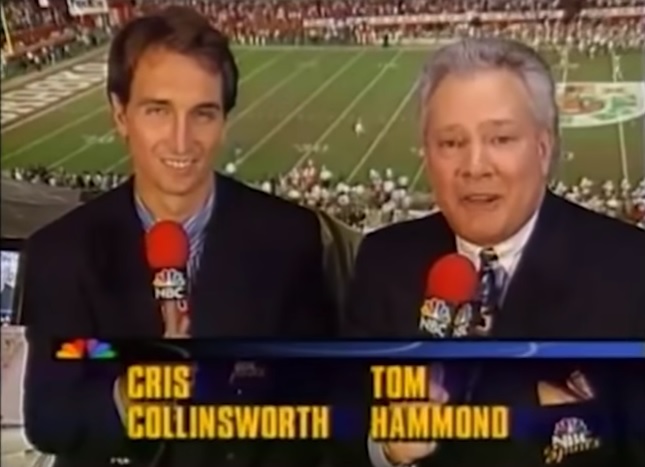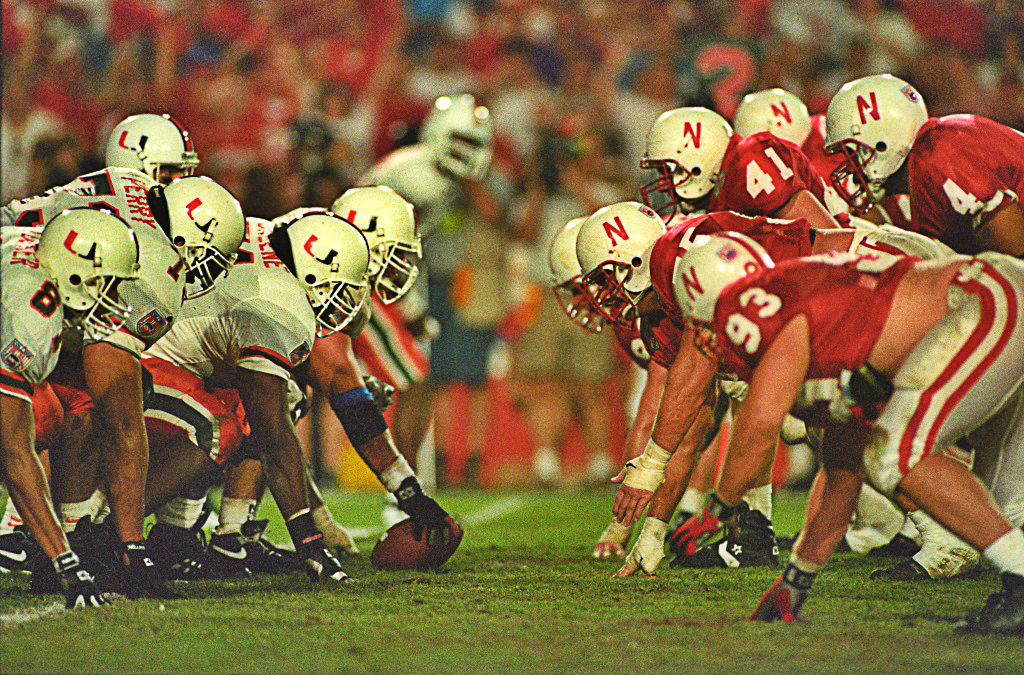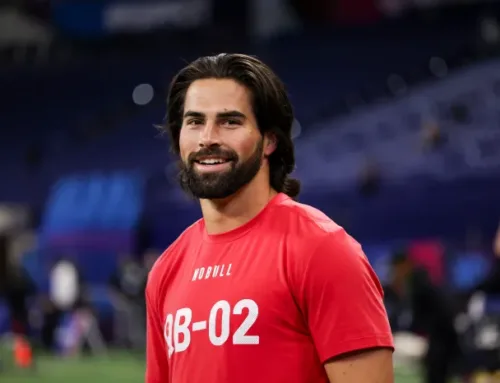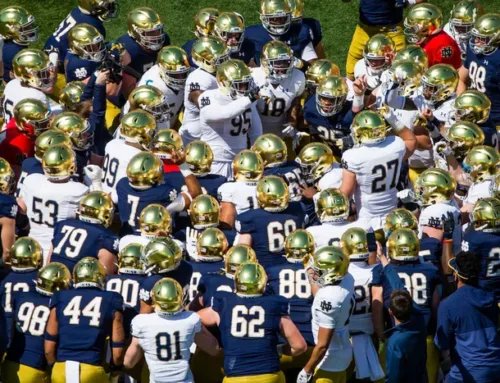Today marks the first of a series of articles dedicated to seasons from the past. We’ll be working in the time frame stretching back to the 80’s but nothing more recent than within the last 15 years or so. Basically, the modern game but nothing from the High Definition era. We want to deal with games that feel like yesterday to some people but look like they are now from generations ago.
The first season we will tackle is 1994.
What’s Going On?
NAFTA was established to kick off 1994, Nelson Mandela became President of South Africa, the Nicole Brown Simpson and Ron Goldman murders occurred, and Jeff Bezos started a company called Amazon.
The Winter Olympic Games in Lillehammer began in February, the FIFA World Cup started a flurry of soccer hype in the United States, Major League Baseball went on the game’s longest strike eventually cancelling the 1994 World Series, and George Foreman became the oldest heavyweight boxing champion in history.
“Schindler’s List” won Best Picture at the Oscars, “Forrest Gump” would earn $329.6 million as the top grossing movie, Woodstock ’94 commenced during the summer, the Ace of Base song “The Sign” was Billboard’s Top 100 single of the year, “The Lion King” soundtrack was the top selling album of the year, Kurt Cobain committed suicide, and Justin Bieber was born.
The Set Up
Notre Dame football’s fate in 1993 is well covered. Florida State lost in South Bend but jumped back to No. 1 in the country following the Irish loss to Boston College the very next week. The Seminoles got to face No. 2 Nebraska in the Bowl Coalition Championship Game, winning by 2 points to secure a title. Due to contractual conference tie-ins with the Bowl Coalition, undefeated West Virginia was left on the outside looking in while placed in the Sugar Bowl with No. 8 Florida, but the Mountaineers lost by 34 points anyway.
Your ’94 pre-season AP top teams included Florida, Notre Dame, Florida State, Nebraska, Michigan, and Miami. Five of these teams would finish ranked, while one (you may guess which one) would not.
The Bowl Coalition, entering its 3rd season in 1994, would finally wreak havoc on college football due to the Rose Bowl not being a part of the system.
Then called Northeast Louisiana–today called Louisiana-Monroe–moved up from I-AA to become the 107th college program in I-A football. The top-flight of college has been adding almost one new team per year ever since.
The ’94 off-season was largely spent addressing rule changes in regards to on-field fighting, particularly surrounding the perceived renegade Miami program that would eventually lead in part to THIS Sports Illustrated cover in June 1995.
Conference drama sent a shock-wave across the country that would be felt two decades later as the Southwest Conference in March 1994 announced it was dissolving beginning with the 1996 season. Eventually, Texas, Texas Tech, Texas A&M, and Baylor agreed to join the Big 8 to form the modern Big 12 Conference. The leftover pieces of the SWC in SMU, TCU, and Rice would join the WAC and Houston later joined the Conference USA.
Texas A&M was on probation and not eligible for the post-season, despite eventually leading the Southwest Conference at year’s end. Auburn was allowed back on television in ’94 but was also serving a post-season ban. Washington was also serving a post-season ban. You gotta love the 90’s back when the NCAA swung its hammer around a lot more freely!
Recruiting
Back in the archaic recruiting days of 1994 most believed Tennessee brought in the nation’s #1 class with several nationally recognized players, among them quarterback Peyton Manning who was entering Knoxville just as Heath Shuler left early for the NFL. Shuler ended up being a massive NFL bust, is now the Representative for North Carolina’s 11th Congressional District, and watched Manning obliterate his school records.
The #1 recruit in the land was Louisiana quarterback Josh Booty who was the first high school player to throw for 10,000 yards in a career and Parade’s National High School Player of the Year. What a year for Louisiana quarterbacks! Booty ended up signing a 5-year deal with the Florida Marlins which included a then rookie-record $1.6 million signing bonus. After hitting .198 in the minors, Booty returned to LSU (where he originally committed for football) in 1999 throwing 34 interceptions in 20 career games. His younger brother, John David Booty, would go on to quarterback the USC Trojans from 2003-07.
Other highly touted recruits from ’94 included Ohio offensive lineman Orlando Pace who became only the second true freshman to start at Ohio State and later the only 2-time Lombardi Trophy winner in history. Linebacker Lamont Green from Miami was the USA Today Defensive Player of the Year and the top recruit of Florida State’s class. He would redshirt and have a slow career before starting his final 2 years in Tallahassee while captaining the 1999 National Championship team.
I found this hilarious blurb in the New York Times from late winter ’94:
“USC had a surprisingly productive day with its signing of punter Adam Abrams from La Jolla, Calif. “Southern Cal hasn’t recruited like this for 15 years,” said [SuperPrep Magazine editor] Allen Wallace, who cautioned fans not to be too optimistic because it has a number of recruits who could have academic problems.”
Offensive lineman Peter Damian from New Jersey and quarterback Gus Orenstein from the Bronx highlighted Notre Dame’s shockingly weak ’94 class that didn’t feature a single Parade All-American, at the time an unthinkable disaster. Damian would break his neck in a swimming pool accident in the summer, enrolled at Notre Dame anyway, eventually transferred to Nebraska, and never played football due to his injury. For his part, Orenstein briefly played for the Irish but would eventually transfer to Michigan State then to D-III Rowan University.
The Regular Season
1994 was interesting in that several blue-bloods had really poor seasons by their standards as Ohio State, Michigan, USC, Washington, Tennessee, Texas, and Notre Dame combined for 28 losses. The counter to that was several other teams put together outstanding seasons in their wake.
Florida State, Miami, Nebraska, Penn State, Alabama, and Texas A&M (the Aggies did tie SMU) all finished unbeaten in their conference play. Plus, Oregon, Colorado, Auburn and Florida only suffered 1 loss each in league play. The top games of the season, included (click on games for highlights):
FSU 20 at Miami 34
Florida 31 at FSU 31
Washington 38 at Miami 20
Colorado 7 at Nebraska 24
Nebraska 13 at Oklahoma 3
Colorado 27 at Michigan 26
Auburn 36 at Florida 33
Penn State 31 at Michigan 24
Washington 20 at Oregon 31
Auburn 14 at Alabama 21 [Birmingham]
Miami was nearly immortal in the late 80’s and early 90’s but lost to Washington in week 4 ending their absurd 58-game home winning streak. The Canes had also lost to Florida State in ’93 further increasing the calls that they were on the decline. However, Miami beat FSU handily in 1994.
The infamous “Choke at the Doak” saw Florida cough up a 31-3 lead in the 4th quarter, allowing FSU to score 4 unanswered touchdowns and finish the game in a tie.
No. 3 Nebraska hosted No. 2 Colorado in late October in a battle between undefeated teams. The Huskers dominated beating a team ranked higher than them for the first time in 8 years and breaking a 12-game losing streak against Top 5 teams. Foreshadowing! Nebraska nearly blew it all in a defensive struggle in Norman against a mediocre Oklahoma squad, but ultimately secured the Big 8 crown.
Who could forget Kordell Stewart’s Hail Mary to Michael Westbrook that stunned Michigan? Staying in Ann Arbor, Penn State’s visit would be their toughest game of the season, although they nearly choked away a visit to Indiana 2 weeks later and needed a late touchdown drive–after initially falling behind 21-0–a week later to defeat Illinois and win the Big Ten.
Washington–carrying the momentum of early wins over Ohio State and the aforementioned Miami game–moved up to No. 9 and faced unranked Oregon. The Huskies were driving for what would’ve been their 6th straight win in the series but a Kenny Wheaton pick six sealed it as the Ducks would eventually go on to their first conference title in 37 years. By the way, weird season for UW who looked like one of the best teams in the nation in the middle of the season only to lose 3 of their last 5 to finish unranked.
Auburn beat No. 1 Florida in the Swamp in mid-October (Spurrier’s first home SEC loss in his 5th season with the Gators) and a tie with Georgia prior to the Iron Bowl was their only blemish. Alabama, for their part, came in 11-0 with several close calls ultimately sneaking past their rivals in Auburn.
In the 3rd edition of the SEC Title Game–moved from Birmingham to the Georgia Dome for the first time–the sixth ranked Florida Gators upset #3 Alabama on a late touchdown pass to win by a single point.
What of the Irish?
Hey, we made a major bowl game! Started out winning 4 out of the first 5 games with a close loss to Michigan, then dropped 3 out of the next 4 games to torpedo the season in a way that hadn’t been seen in 7 seasons. Notre Dame took care of business in a shootout against Air Force, tied USC in the regular season finale, and was invited to the Fiesta Bowl for reasons to be discussed below.
Really, the 1994 season was a punch in the face and a wake up call of a new era for Notre Dame. It’s been hashed out a million times before but the jump from ’93 to ’94 was swift and brutal. With Vinny Cerrato’s recruits as upperclassmen the Irish went 64-9-1 (.871) and 36-21-1 (.629) in all the other Lou Holtz seasons. The ’94 campaign was the first without any Cerrato seniors on the team and a harbinger of things to come for the program.
Bowl Season
No, the bowl season hadn’t been watered down at this point yet. Just 38 teams (35.5% of the country) played during the post-season as compared to 2018 when 60.0% participated.
Now, we must discuss the Bowl Coalition.
Cotton Bowl: #21 USC 55 vs. Texas Tech 14
Fiesta Bowl: #5 Colorado 41 vs. Notre Dame 24
Sugar Bowl: #7 FSU 23 vs. #4 Florida 17
Rose Bowl: #2 Penn State 38 vs. #12 Oregon 20
Since the Big Ten and Pac-10 didn’t participate in the Coalition it ultimately cost Penn State any chance at a National Title despite finishing 12-0. A couple years ago I wrote about this 1995 Fiesta Bowl curse and explained how the likes of Texas Tech and Notre Dame (combined 12-9-1!!!) were picked for these prestigious bowls:
Here’s the deal: The SEC, Big 8, Southwest, ACC, and Big East all participated [in the Bowl Coalition]. The Pac-10 and Big Ten still sent their league winners to the Rose Bowl but otherwise played along. The Tier 1 bowls were the Orange, Sugar, Cotton, and Fiesta. To be invited, you had to be a conference winner, an at-large conference runner-up, the 3rd-place SEC team (the loser of the SEC title game was contractually obligated to the Citrus Bowl), or Notre Dame.
The Sugar welcomed ACC #1 Florida State and SEC #1 Florida.
The Cotton welcomed Pac-10 #2 USC and Southwest #1 Texas Tech. Actually, Texas A&M was by far the SWC league champion (10-0-1 overall) but were serving a post-season ban. There was a 5-way tie for the SWC league title, and the Cotton selected the 6-5 Red Raiders. It was dumb, they got slaughtered.
The Fiesta welcomed Big 8 #2 Colorado which left several teams vying for the final Tier 1 slot: Big East #2 Virginia Tech (8-3), ACC #2 NC State (8-3), and thanks to another bowl ban (Auburn) SEC #3 Tennessee (7-4). Or, the Fighting Irish of course.
USC absolutely clobbered an over-matched Texas Tech team while racing out to a 48-0 lead, Colorado led 31-10 at half over Notre Dame on their way to an easy win, Florida State won the re-match against Florida after finishing the regular season against each other, and Penn State had to be content with the memories of Californian pageantry in an easy win over Oregon.
Orange Bowl: #1 Nebraska 24 vs. #3 Miami 17
1994 really was all about the snake bitten Tom Osborne finally breaking through on the big stage. He came into the season having lost an incredible 7 straight bowl games, 6 of them major bowl games. He also had 6 finishes in the Top 6 at this point in his career, but no championship. I can’t even imagine how much roasting he would receive in the Twitter era today.
This would be Nebraska’s 4th straight appearance in the Orange Bowl, no less. They were shutout by Miami in 1991, beaten by a couple scores at the hands of Florida State in 1992, and missed a last-second field goal in 1993 in a re-match with the Seminoles. The Cornhuskers would come in as 1-point underdogs to the Hurricanes.

AHHHHHHHHHHHHHHHHHHH.
This was the Nebraska team to break through though and they proved it. They spent the last third of the season as the #1 team with maybe Osborne’s best defense to date and more or less cruised throughout the regular season. Except, they were nearly derailed by quarterback issues.
Star quarterback Tommie Frazier missed the last 8 games of the regular season with a blood clot in his right leg. Luckily, the highly touted Brook Berringer stepped in and played at a high level. The uncertainty at quarterback heading into the Orange Bowl led to Miami middle linebacker and future Hall of Famer Ray Lewis to proclaim, “The Cornhuskers couldn’t win with Superman at quarterback.”
Ray would be wrong.
Frazier started the game and was actually pulled by Osborne for poor performance. Trailing 17-9, Frazier re-entered the game and engineered a pair of 4th quarter touchdown drives to seal the win.
Nebraska’s OL was huge in ’94 at 295 on average, 13 pounds lighter than the Irish ’18 line.
Obviously, this win transformed Osborne’s legacy. No longer the big game goat, he ultimately finished his Huskers career going 60-3 from 1993-97 winning 3 National Titles* in the process.
*No need to recognize Michigan in 1997.
Heisman Controversy?
Looking back the least you can say is that the race between Colorado’s Rashaan Salaam and Penn State’s Ki-Jana Carter should’ve been a little bit closer. On the surface, Carter was the top offensive player on a team that opened at No. 9 and spent the entirety of the season inside the Top 5 from week 4 onward while finishing undefeated. Most seasons in college football history the Heisman would’ve gone to Carter.
However, Salaam (who tragically committed suicide^ just over 2 years ago) and his burst onto the college football scene were just too much to overcome from the early part of the season.
Colorado RB, Rashaan Salaam 1743 points
Penn State RB, Ki-Jana Carter 901 points
Alcorn State QB, Steve McNair 655 points
Penn State, Kerry Collins 639 points
For all intents and purposes, Colorado was neck and neck with Penn State in the rankings for most of the season culminating in the Nittany Lions rising to No. 1 with the Buffaloes in the second spot in week 8. Salaam would be slowed down considerably in the impending loss to Nebraska but by then the damage had been done for voters.
Through the first 6 games Salaam rushed for 1,053 yards against 4 ranked opponents. Although Carter finished with an impressive 7.8 rushing average and 23 scores he had his teammate Kerry Collins steal some votes and Salaam finished with 2,055 rushing yards, 6.4 per carry, and 24 scores. He was only the 7th player ever to eclipse the 2,000-yard mark at that point in history so the Heisman was certainly justified.
For what it’s worth, there have been 24 more seasons of at least 2,000 rushing yards since 1994.
^The troubled Lawrence Phillips finished 8th in Heisman voting with over 1,800 rushing yards and also committed suicide while in prison back in 2016.
The Aftermath
After 3 years this would be the final Bowl Coalition season, ushering in the newly formed Bowl Alliance. In attempting to force a #1 vs. #2 matchup during bowl season, the Alliance dropped some of the conference tie-ins and decreased the “Alliance” bowls to the Sugar, Orange, and Fiesta with a ranking system determining the best teams from a combination of the AP and Coaches Polls.
It still didn’t work due to the Big Ten and Pac-10 refusing to take part which screwed things up and led to the BCS system 3 more years down the road.
~~~
The infamous Sports Illustrated cover linked above preceded the end of the NCAA’s 4-year investigation into the Miami Hurricanes which dropped a post-season ban, 3-years probation, and a reduction of 24 total scholarships on the program in December 1995. This heralded the Canes’ wandering in the wilderness for several years before their memorable 4-year run beginning in 2000.
Alabama got hit, too! In August after the ’94 season the NCAA handed down a one-year bowl ban, 3 years probation, 26 scholarships reduced over 3 years, and the forfeiture of 8 victories from 1993 due to numerous rules violations. This also led in part to the Tide wandering in the wilderness for the better part of the next decade or so before this guy Nick Saban showed up in Tuscaloosa.
~~~
1994 really was all about watching the beginning of the comet that was Nebraska come to dominate the game with their old-school offensive approach only to then see them slowly disappear from the national radar by the early 2000’s. The Huskers win would the Big 12 in 1999 under second-year head coach Frank Solich but it’s their only conference title over the last 22 seasons after winning their league 21 times from the preceding 35 seasons. Still, the mid-to-late 1990’s was a dynastic era for the Huskers ushered in by this National Championship.
In fact, the 1995 Nebraska team would go on to lay claim as one of the best in college football history. They won their games by an average of 38.6 points, scored 53.2 points per game, breezed through the last year of the Big 8 conference, and demolished undefeated Florida 62-24 in the National Championship Game. You may have remembered Tommie Frazier’s “The Run” in that one.
~~~
One could argue 1994 was the first big shot of conference realignment which would continue to echo to this very day as the SWC announced it would dissolve. Up until this point, the changes were largely revolving around independents finally joining a league. A brief modern history of realignment until 1994:
1983: Georgia Tech moves from I-A Independent to the ACC.
1991: Boston College, Miami, Pitt, Rutgers, Syracuse, Temple, Virginia Tech and West Virginia move from I-A Independents to the newly formed (for football) Big East.
1991: Arkansas moves from the SWC to the SEC.
1992: Florida State moves from I-A Independent to the ACC.
1993: Penn State moves from I-A Independent to the Big Ten.
Once the SWC disbanded and the Big 12 was created it destabilized the whole system. Wandering eyed programs like Texas A&M (moved to SEC in 2012), Nebraska (moved to Big Ten in 2011), Colorado (moved to Pac-12 in 2011), Missouri (moved to SEC in 2012), and Texas (still TBD) were all hot topics beginning with zest in the ’94 off-season. It took nearly two decades but eventually most of those rumors would come true.





That Penn State offense was loaded – they also had TE Kyle Brady, who the Jets would make a top ten pick that spring, and WR Bobby Engram, who won the first-ever Biletnikoff that year and eventually went on to have a pretty decent pro career. I think their average scoring drive that season was 2:30 or something absurd like that. Carter was good, but there was definitely some attention drawn by his teammates and there was more of a sense that he might’ve been a product of the system than there was with Salaam. Colorado was in pretty good shape too – in addition to Kordell and Westbrook they had Rae Carruth and Christian Fauria, but as I remember there was less hedging on Salaam’s role in their success than there was on Carter’s role in Penn State’s success.
After bowl season, Penn State was 12-0 and +312 on point differential. Nebraska was 13-0 and +297. They both passed the eye test with flying colors – they were so clearly better than everyone else that it really accelerated the “so unfair that we didn’t get to see the two best teams fight it out” talk.
Also, your footnote on the 1997 Michigan team is completely fair – their share of that title was absurd, a sock monkey could see that Nebraska would’ve demolished them if they played each other. Heading into bowl season, Michigan was 11-0 with a point differential of +203 and was getting way too much credit for beating at-gametime top five Ohio State and Penn State, who would each get smacked in their bowl games by Florida State and Florida, respectively. Meanwhile, Nebraska was 12-0 heading into bowl season, with a point differential of +368 and wins over four end-of-season ranked teams. Nebraska obliterated then-#3 Tennessee 42-17 in the Orange Bowl, while Michigan had to come from behind and hold off then-#8 Wazzu to win the Rose Bowl 21-16.
The Big 12 was on the softer side that year, but even so, I don’t really understand how anybody looked at those two teams after bowl season and thought Michigan was better. It wasn’t close. Stupid writers.
Also, Charles Woodson is fat.
It’s pretty clear the writers disregarded all that information and voted for Michigan because Nebraska won the Missouri game by basically cheating (the infamous “Flea Kicker”). It was something of a rough justice situation.
I knew about the 1996 Florida/FSU rematch, but I had no idea they played in the Sugar in ’94, too. 5 games in 3 years between them! Insane. Forget Penn State/Nebraska, that’s the real reason the Bowl Coalition/Alliance needed to go.
My freshman year. I came out of the first game against Northwestern thinking we’d win at least 2 NCs before I graduated. We then lost to Michigan in still one of the best games I’ve ever seen in person. And then…well…spoiler alert: we didn’t win 2 NCs before I graduated.
And the Chairman sent me to France… maybe that’s the problem! Anyway, sorry, KG, you deserved better.
My freshman year as well. Someone in our group camped out with our student IDs and we ended up with 7th row seats in the corner. That Michigan game was my first ever Notre Dame game in person. Mayes caught the go-ahead TD right in front of us and we literally almost died in the ensuing melee.
And then… Remy ****ing Hamilton. If I ever meet that guy I’m going to have to work very hard to resist the urge to punch him in the face.
I already hated Michigan before that, but seeing a Michigan fan (student probably) jump in Stonehenge after the game pissed me off for life.
Very nicely done, ERic.
This was a super start to what looks to be a super series. I would put in a pitch for somewhat more of ND in a given season (after 60 of them it does tend to blur some of the details!) For 1994, yes, brutal slump, but was it only talent dropoff? And if KG remembers the Michigan game, it must be memorable — I was deployed that month, so I don’t know.
I went to the FSU game in Orlando. Had no tickets but stopped by the ND will-call window and they were like, “Sure, here’s a couple on the 40.” They almost couldn’t give them away. Powlus got brutally sacked early and was undoubtedly suffering from a concussion, but we covered the spread! Woop woop.
Those Nebraska teams seemed to be entirely filled with crazy steroid freaks. Amazing that Osborne managed to parlay that travesty into some respectability as an AD. But karma bit him in the a$$ with that move to the B1G. ROFL!
Sometimes you wake up and realize you’re living a lie.
When I was a junior in HS, my HS had the best football season it’s ever had. Went undefeated, swept through the first few rounds of the playoffs, and made it to the state semifinals. I decided to make the 4 hour drive with my girlfriend and her family to go see the semifinal game, at Bradenton Manatee, a powerhouse south of Tampa. My HS went up in the first half, but in the second Bradenton Manatee’s QB was unstoppable–we simply couldn’t tackle him. He ran wild and they won by a lot. That QB was named Tommie Frazier. They of course went on to win the state championship, and our FB team was never all that good again. I’ve told this story a few times whenever he comes up, because he destroyed us that night before going on to destroy many a CFB team.
Except that wasn’t Tommie Frazier. I was about to post my story as a comment, but went to go look at Tommie Frazier’s wiki page first. Reading through, Frazier went to Manatee but his freshman year at Nebraska was 1992. Wait–that was my junior year. Was it my sophomore year we went to the playoffs? But I wasn’t dating that girl that year…hold on. So I go check my HS’s wiki page, and yes, our one good football team ever was 1992. So whomever that QB was that killed our season, it was Tommie Frazier’s backup. I’ve thought we lost to Tommie Frazier since the mid-1990s.
Everything is a lie. Nothing is real.
Who was the backup quarterback??
You ain’t going to believe this….
…but after googling, it was Willie Taggart.
Amazing.
Found it on a list of the Tampa-St. Petersburg top 90 prep football players of the last however many decades from a few years ago when Taggart was still coaching at USF.
http://90th.heraldtribune.com/2015/10/01/90-best-local-football-players/
Tommie Frazier was 3rd. (Peter Warrick was ranked 1st?!?)
Taggart was 46.
“46. Willie Taggart. Ex-Hurricane QB (Class of 1994) won a state title under Joe Kinnan. In his third season as the head coach at South Florida.”
Just for fun, also on the list:
#67 Jared Clark
#84: Courtney Watson
#59: Alvoid Mays, Safety, nicknamed “the Void,” played at WVU then in the NFL. Burned by Rocket Ismail in the 89 Fiesta Bowl, I can still clearly remember Dick Enberg saying “Well now we know what happens when you shoot a Rocket into a Void.”
“Some years ago, a sportswriter asked Notre Dame football coach Lou Holtz if he realized that freshman recruit Gus Ornstein might become the school’s first Jewish quarterback. Holtz retorted: ‘What’s the big deal? After all, there’s a Jewish mother standing on top of the Golden Dome!'”